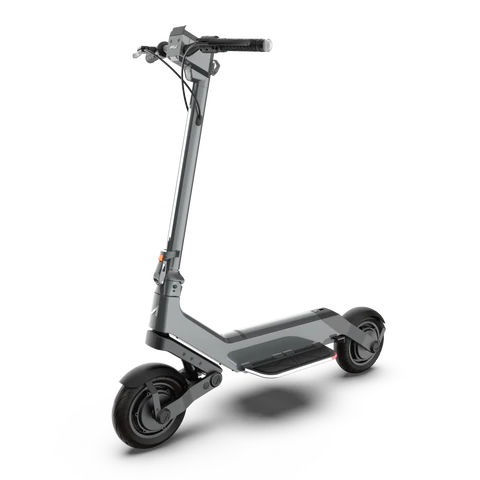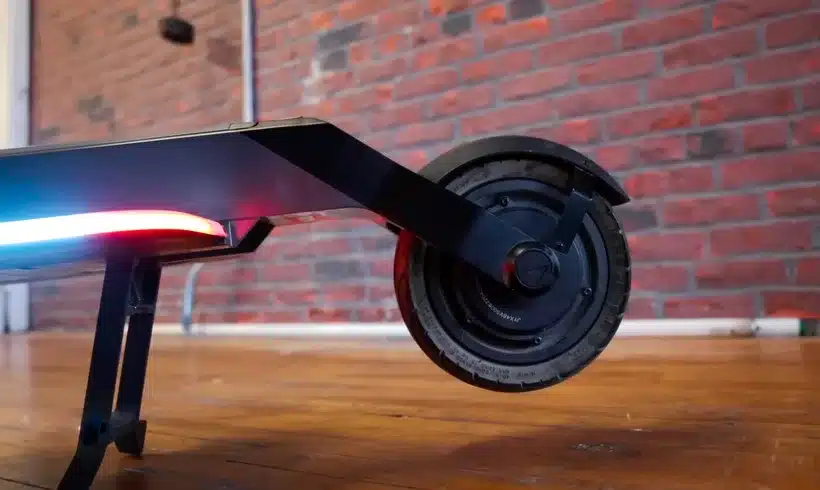The Apollo Explore (coming in 2024) is not the Montreal-based scooter company’s first bold design statement (think: Apollo Pro, Apollo Rover), and we hope it’s also not the last. The Apollo Explore is the first model we’ve ever seen featuring a deck that extends from both sides of the battery compartment, instead of running along the top. This thing looks… weird? cool? both? Either way, we’re excited to try it. The removable battery is a welcome touch, the first of Apollo’s lineup to have this feature. If you’re already intrigued, reservations are open here, and if all goes according to plan, you’ll get yours sometime in Q2 2024. Let’s look at the specs:

Specs
Price: $1699 (expected)
Speed: 40 mph
Range: 12 miles real-world
Weight: 52 lbs (expected)
Max Rider Load: unknown
Motor: 2 x 500W
Water resistance: IP66
Tires: 10-inch self-healing
Suspension: Front swing-arm
Battery: 52V 13 Ah ( Wh) Samsung 21700
Charging time: unknown
Features
Swappable battery
Handlebar-mounted turning signals
Wireless phone charging
Built-in GPS tracking device
Customizable horn sound

Things we love
The deck of the scooter is completely different: platforms extend from both sides of the central frame, which houses the removable battery. They also retract, which makes this scooter surprisingly portable.
The Explore features a super-long front headlight that takes up most of the length of the stem. You can even use the app to display the battery level using the front light! There is also a proper headlight which lights up the road in front of you, as the elongated headlight is more about being seen by cars in front of you.
Apollo has by far the best integrated app for scooters, with dozens of features and capabilities. The Apollo Explore can receive over-the-air updates and performance tweaks through the app, ensuring the scooter is constantly evolving and improving. You can also choose between ten acceleration modes, ten deceleration modes, and four customizable speed modes. You can digitally “park” the scooter using the app, which locks the wheels in place and sets off an alarm if someone attempts to move it. The app also controls the functionality of the display; each user can program the display to show their preferred metrics such as speed, battery capacity, controller temperature, etc.
The removable battery is somewhat of a relief, considering the battery itself is only 8 Ah. We’d imagine most people using this scooter as their daily commuter are going to want an extra battery.
The charging port is mounted in the rear, increasing protection in a crash. Side-mounted charging ports can easily scrape against the ground or get dented.
The kickstand looks different from most scooters: instead of a side-mounted extending pole, it is a full-width kickstand (like on the Apollo Pro) which suspends the rear wheel, similar to many mopeds. You can deploy it from either side.
The Explore features turning signals on the outside of handlebars, which makes it MUCH more visible to cars both in front and behind.
The Explore comes with a built-in GPS tracking device, which if tampered with, locks the scooter entirely. If someone tries to move the scooter, it sets off a blaring alarm. Pretty neat!
The front and rear fenders hug the wheel, which makes a lot more sense than the design on Kaabo models where the suspension is literally raised a foot above the wheel. Closer fender: more effective at catching dirt before it reaches the rider.
Although not shown on V1, the production model will feature a physical bell, in addition to the customizable horn.
Using Apollo’s phone holder (which must be purchased separately) you can mount your phone landscape, and still see the speed + battery on the display. Mounting your phone portrait covers the numbers on the display. Also, the phone mount charges your phone while riding.

Room for improvement
No rear suspension (possibly rubber block coming on V2)
The Apollo Explore features drum brakes instead of disc brakes, which reduces maintenance but increases quality concerns. However, Apollo has stated that independent testing shows that the drum brakes perform “similarly” to hydraulic disc brakes.
The battery is… tiny. 416 Wh is the smallest battery (by a large margin) that we’ve ever seen on a 40 mph scooter. The second smallest, by comparison, is the Varla Eagle One (also a 40 mph scooter), which has a 946 Wh battery. Most scooters in this performance range have 1200-1300 Wh batteries. In their V1 walkthrough video Apollo stated that the expected real-world range is 12 miles, which matches up with the battery size + weight + speed. That makes the Explore the most expensive ($1699) scooter with a sub-15 mile real-world range, ever. Second place goes to the Unagi Model One Voyager, with a 14.6 mile real-world range, and a price tag of $1490.
Scooter Comparison Tool
Use our Freshly Charged Scooter Comparison Tool to evaluate this scooter alongside more than 500 other scooters. Compare and organize scooters by factors such as price, top speed, battery size, weight, water-resistance rating, and more!







